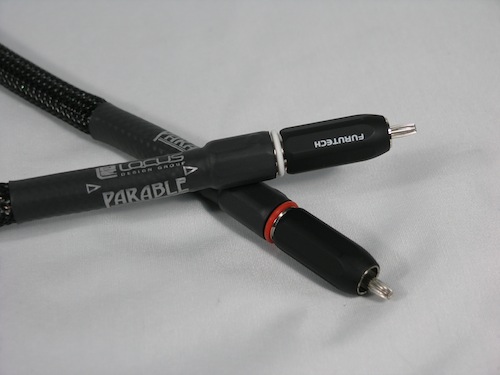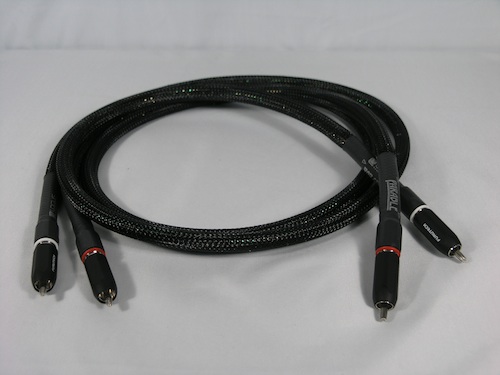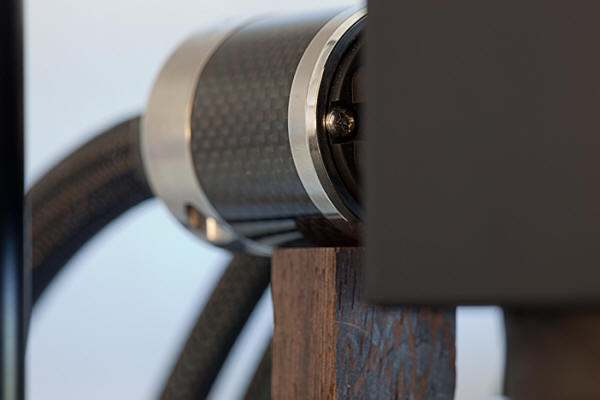|
You are reading the older HTML site
Positive Feedback ISSUE 54
The Mystical, Immersive Parable Analog Interconnect:
Locus Design's Latest Milestone Accomplishment
According to the Oxford English Dictionary, the definition of the word parable is, "...An allegorical or metaphorical saying or narrative; an allegory, a fable, an apologue; a comparison, a similitude. Also: a proverb, a maxim; an enigmatic or mystical saying (now arch.)...". I have to say, the words "enigmatic or mystical" really resonate with me when I think of listening with the Parables. All cables have a sound. Nothing really gets completely out of the way of the music; and some cables are nothing more nor less than sophisticated tone controls. However, every so often, a cable will come along that compels you to hear the music and brings you closer to the sound than any other cable you've heard. In the past, I would say the Audio Note UK Sogons or the Kondo Sounds Labs KSL-LP's accomplished that most effectively; but by comparison, the effect is subtle. Whether connecting my Ayre C-5xeMP universal stereo disc player or my Rega DAC—which I used for the burn in period—to the Manley Skipjack in my digital music server, the Parables uniquely unveiled the subtleties in the music and allowed me to hear, dare I say forced me to realize, the true pathos in Elvis Costello's "North" from HDtracks, an ode to the trials and tribulations of love. Again, I stress the words "enigmatic or mystical" as the depth and richness that the Parables conveyed took on shaman-like proportions, as if an incantation have been uttered over the Rega DAC and it took on the ability to construct a direct connection between myself and the performance, no matter how simple or complex, minimal or layered and processed. At $5450 for a 3 foot pair of these exquisite black analog interconnects, they are far from inexpensive; but in terms of value for the dollar, they could cost $15,000 and still be a bargain given what they do. They also use the superlative Furutech FP-120 RCA connectors that I had soldered onto twenty feet of Cryo-Parts/Whiplash Audio Dynamics Sapphire Pro cables to connect my Theta Compli Blu universal video and audio disc player to the Skipjack, a substantial improvement for a bulk cable much less one made with the care and exotic materials of the Parables. The FP-120's are locking connectors, so you know you get a physically secure connection; however, their filament architecture really makes them special. According to Chris Johnson at the PARTS CONNEXION, here's how they work and why they sound so good: "Well, it might be best for Furutech to comment... but, if you have the part in your hand, it's easy to see... instead of the center pin being a solid piece of plated metal, machined from a rod... the Furutech Filament pin is constructed from a plated wire... and that wire or FILAMENT is tightly looped, from the face of the plug, to the tip, and continually wound around an axis...bulging in the middle. When inserted into an RCA female, that tightly wound bulged wire, acts like a very firm spring.... making excellent contact with the female receptacle of the 'mating 'RCA jack. There should not be any hot spots or loose areas... around the circumference of the part.... equal and strong pressure inall directions, out from the central axis. It's fairly unique. I saw this first on a Clear Audio USA male plug, 15years ago...but never since...until the Furutech." One word that also comes to mind in thinking of the Parables is "quiet", like the SME Model 30 turntable which—for all its hoopla—remains extremely quiet; to that end, I asked Lee Weiland, the owner of Locus Design and sole designer/builder of the Parables, about his design goals and how he accomplished them. His reply follows: "Over the last 25 years, I have been striving to come up with methods of building the 'quietest' cable available. By 'quietest', I mean a cable that is immune to the environment it is placed in both electrically, and mechanically as possible. In addition to this immunity to outside influences, a 'quiet' cable must exhibit high self-damping characteristics, so that any excitement to the internal signal conductors (via the components to which the cable is attached) is immediately quelled, and this energy is then dissipated as low level heat. In a nutshell, this is my 'philosophy' of cable design.
I look at a cable as a 'whole', not just a collection of component parts. While I use the best materials available (custom drawn wire, Furutech or Bocchino connectors, Mundorf solder, etc.), I am striving for gestalt, in order to produce an ends product that is remarkable. For myself as a designer, to get my cables from 'good' to 'great' required me to start thinking differently, and visualizing the end product as a complete entity; including visualizing how I wanted this entity to perform, and then setting goals and standards for this entity. Once I started thinking like this, I designed the Axis, Nucleus and Cynosure USB cables, the Vision interconnect, the Core digital cable, and the Keynote power cable, all of which have been universally praised, and have won many awards. All of which leads us to the Parable.
The Parable is a result of my latest thinking on analog interconnect design, and takes all of the technologies I have developed over the years to their extreme, which of course meant not designing to a price point, and using what I feel are the best materials for the job, regardless of cost. To this end, I started at the beginning, and looked at the basic building blocks of an analog interconnect cable, the wire (conductors), the shielding, the damping, the jacketing materials, the ends, etc.. In short, I carefully considered each element in the cable, and picked those elements that worked together to achieve my goal of producing the 'quietest' cable that I know how to make. While I have always had custom wire drawn to my specifications, the wire used in the Parable is my best work yet. In addition to using the highest quality raw materials, and most advanced manufacturing techniques available (like all of my wire), I developed an insulator with a remarkable resistance to being excited, i.e., it is very 'dead', and has a very low Q ring [resonance]. This wire has many upsides, but is also incredibly expensive to manufacture, so it is only suitable for cost no object products. I then have this wire weaved into a proprietary braid, which forms the core of the Parable. The braid serves to tie the conductors together as one unit, while still allowing each conductor to be isolated from each other. Around this 'core' unit, I then add various layers of damping and shielding materials; including, but not limited to, cotton, nylon, Teflon, Mylar, SPC braid, carbon fiber, and others I will not disclose. All materials are chosen for their ability to work together to damp and shield the inner core from outside influence, as well as dissipate any energy that the conductor core may have picked up from the components they are tying together. As an aside, all Parable's will be built by me personally, as I am the only one who knows exactly what goes into the cable, and I am not going to share this knowledge with anyone, anytime soon."
Thinking about it, everything that Lee wrote makes sense; this cable—again noting that all materials have sonic signatures—still has a quieter, more musically engaging sound, perhaps I should say allows more musically engaging sound, than any other cable I have heard; my only regret is that I can afford one pair alone, connected at the moment I am writing this to the almost paradoxically superlative Rega DAC fed by the Cynosure USB cable, Sonicweld Diverter, Core S/PDIF cable and with a Keynote power cable attached to the it via an IEC 60320 C14 Plug to IEC 60320 C5 Connector sourced from Amazon, supported in perfect horizontal alignment with the top of the Rega and mechanically grounded to the Quadraspire shelf by a small cube of African Black Wood, also bearing an extremely low natural resonance. Bearing all this in mind, I only intended to connect the Parables to the Rega DAC as a temporary measure to given them an extra few hours of burn in; once I felt they had reached a plateau—not really that many hours in—I moved them to the dCS Debussy, the one DAC I have that really deserves the Parables if cost alone remains one's metric (setting aside the 16/44.1 Audio Note DAC 4.1X Balanced); and more magic happened. Playing the 24/96 copy of Equinox by Markus Schwartz & Lakou Brooklyn on Soundkeeper Recordings, I was immediately taken by just how much this sounded like good analog, warm, open, musically engaging and again possessing that quietness that I associate with the Model 30 and maybe my Fat Bob Reference on its custom built stand. Everything just seemed to flow as if I had played a 15 inch/second, ½" analog master tape. So I had not discovered some bizarre synergistic relationship between the Rega DAC and the Parables alone; I had discovered music, and music like I had never heard from my digital music server. One last test remained, which was to play some very high-resolution material through the Ayre QB-9, the only DAC in my digital music server that can play above 24/96 via USB right now. The Ayre has an intrinsically more open, more papery-fine quality than the either the Rega or the dCS DAC's; but it will play 24/176.4 and 24/192 recordings via its USB input, its only input. Again, I remained favorably impressed with the sound quality of the 24/176.4 copy of The Raven by Rebecca Pidgeon from HDtracks. It sounded very natural and very analog-like, again thanks largely to the Parables; however, I discovered John Ward: Consort music for five and six viols by Phantasm at 24/192 from Linn downloads as the real testament to the Ayre QB-9/Parable combination. In fact, what I discovered is that, like most high-end cables, the Parables do require some settling in after getting jostled around between DAC's; however, by the end of The Raven and the beginning of John Ward: Consort music for five and six viols, the sound of the Ayre QB-9 had appeared to mellow substantially; and I believe that has to do with the Parable's unique ability to settle in very fast and reject extraneous electrical and mechanical noise. So what can I say? Locus Design has a real winner and a landmark product on their hands; now back to the music. Kindest regards, Andy P. S. Having reconnected everything in its "normal" arrangement with the Ayre QB-9 feeding the Manley Skipjack via my Kondo KSL-LP analog interconnects and the dCS Debussy feeding the Skipjack via the Parables, I think there's no doubt that I lost I little music from the Ayre when I went back to the KSL-LP's. It is true that the Parables have a certain warmth to them that the Kondos don't share; and that does make the Parables slightly on the sunny side of neutral. However, they remain very seductive and mate so well with all of my DAC's that I don't care; deciding which DAC deserves then practically requires a lottery; but I think—for now—no doubt the dCS comes out the winner. Locus Design http://www.locus-design.com
|



